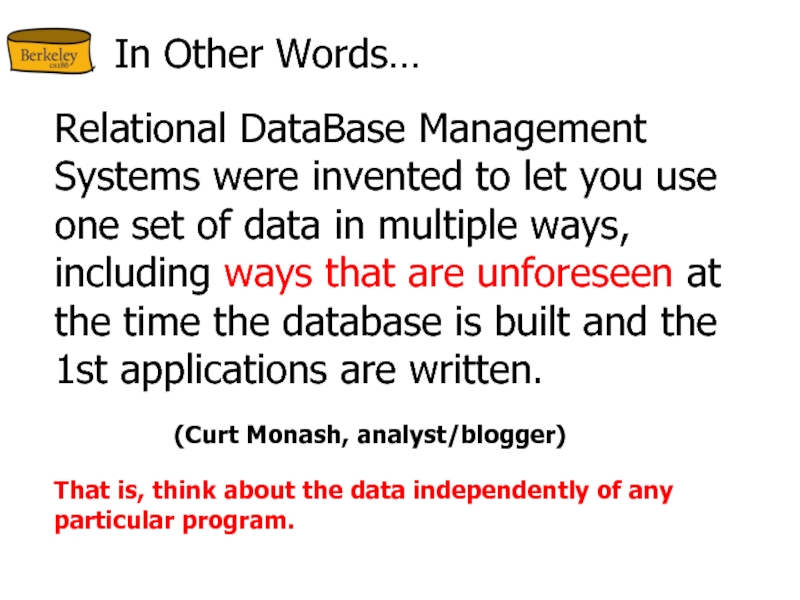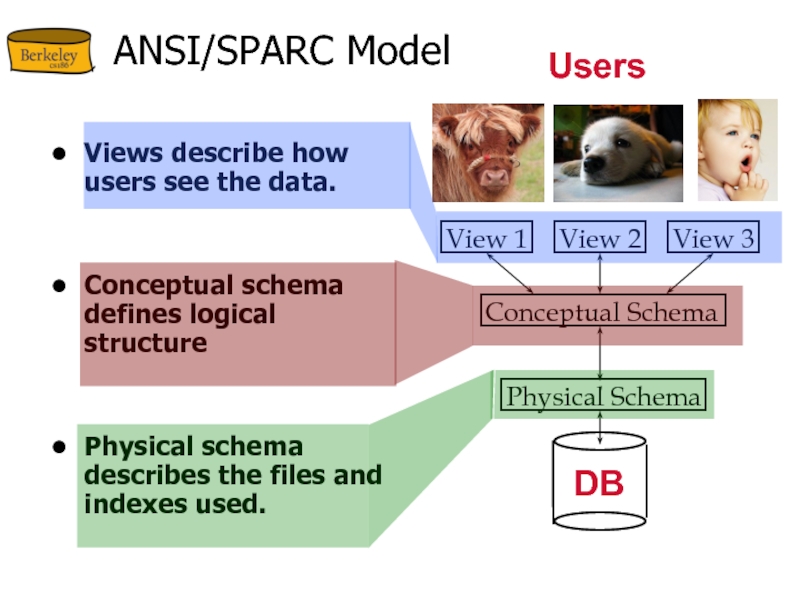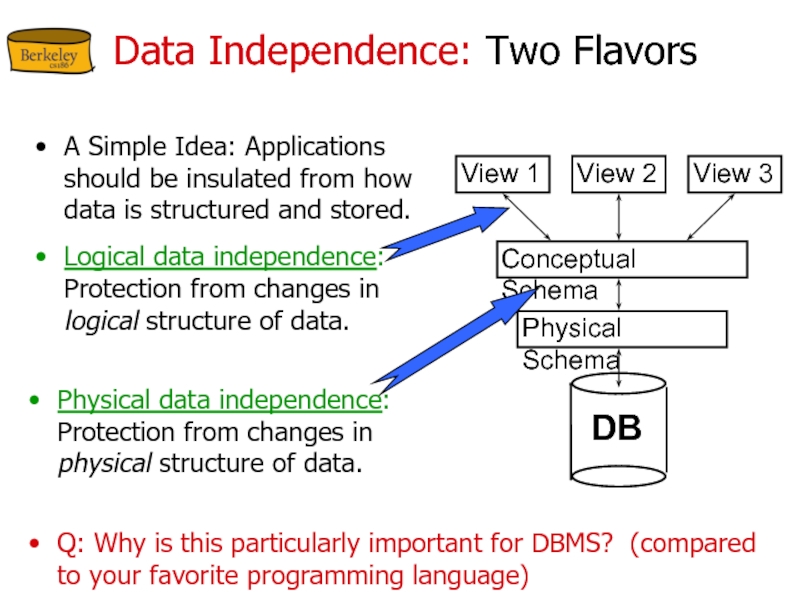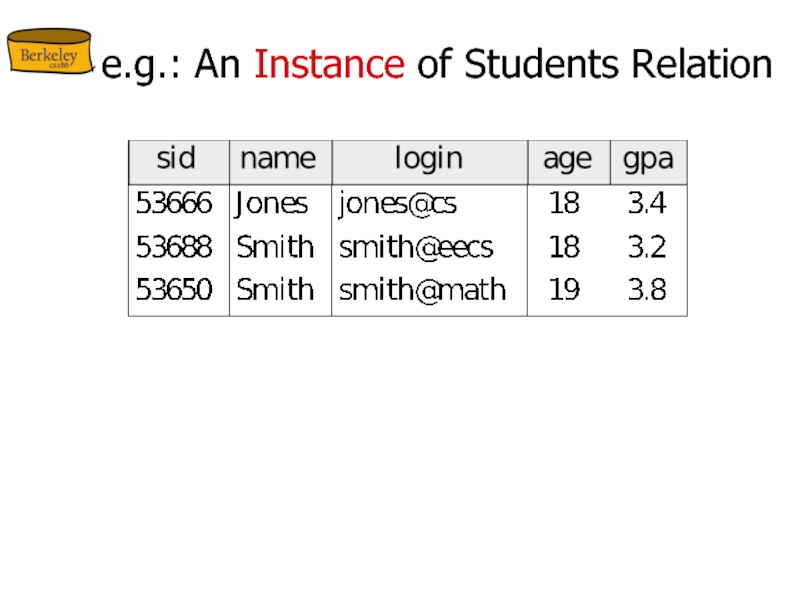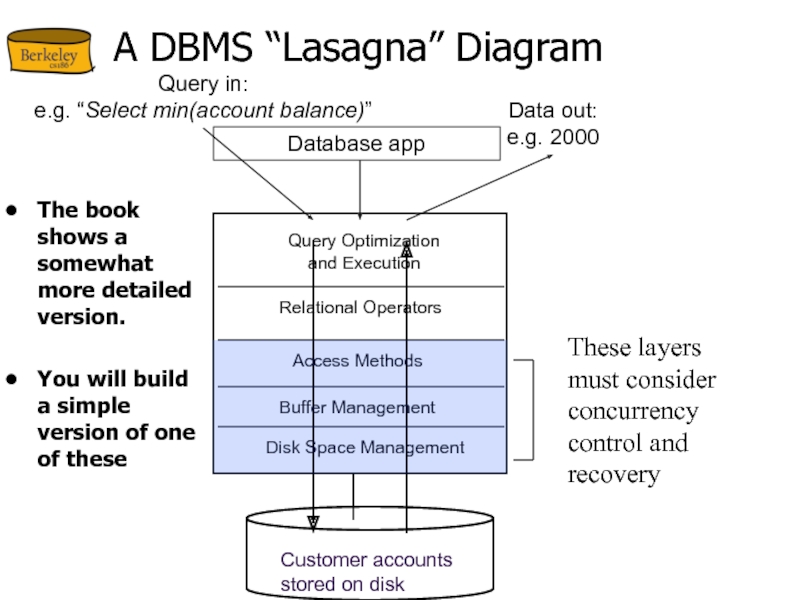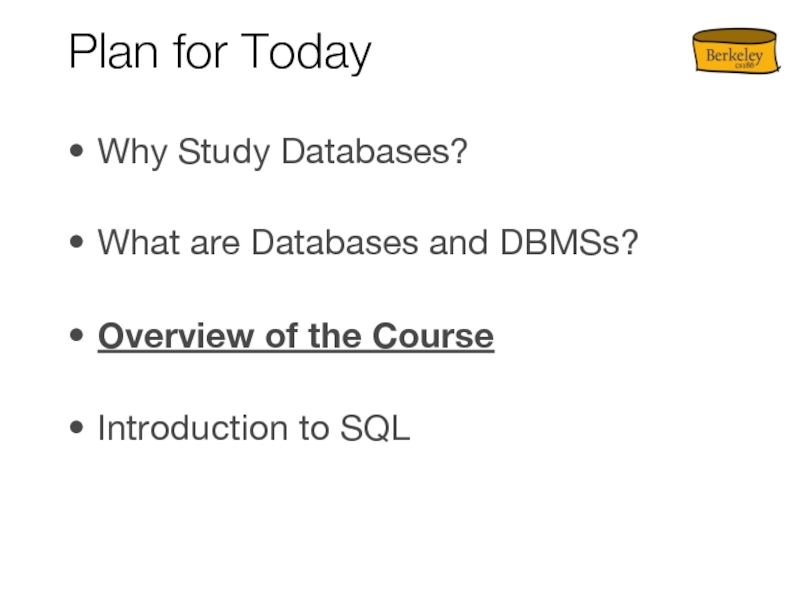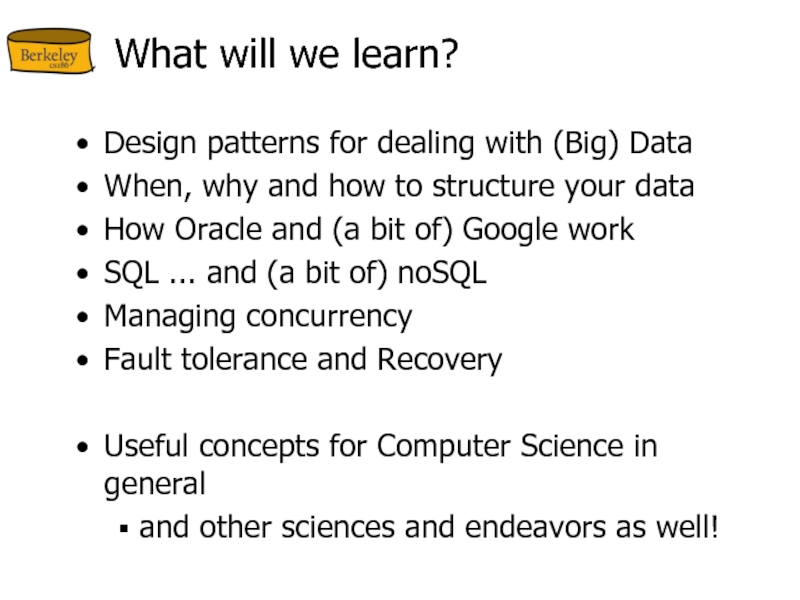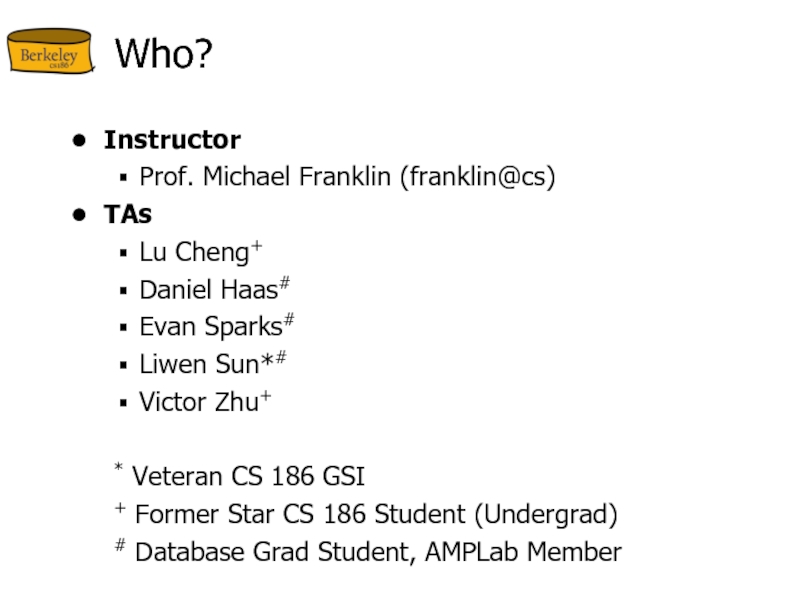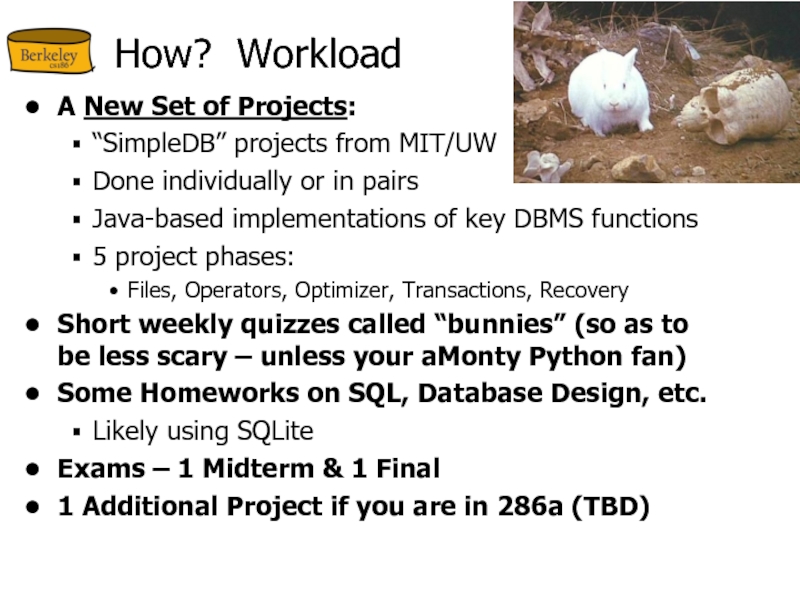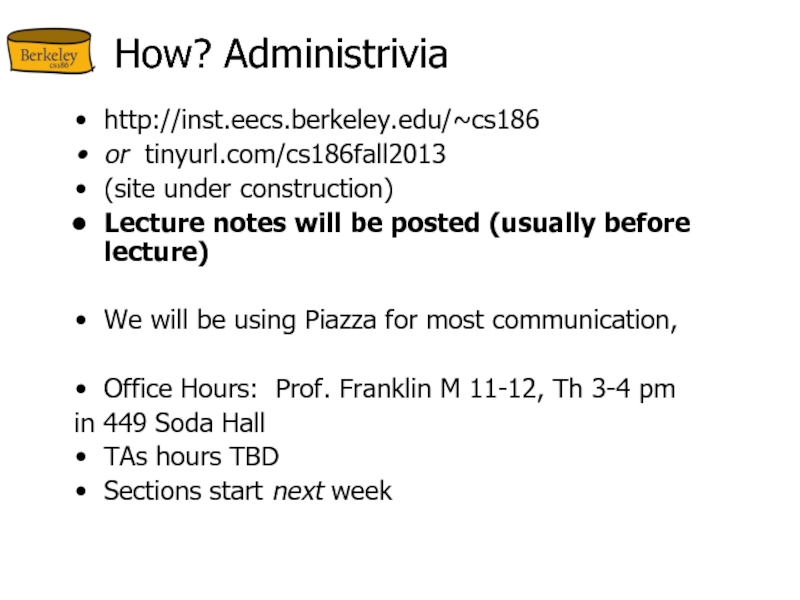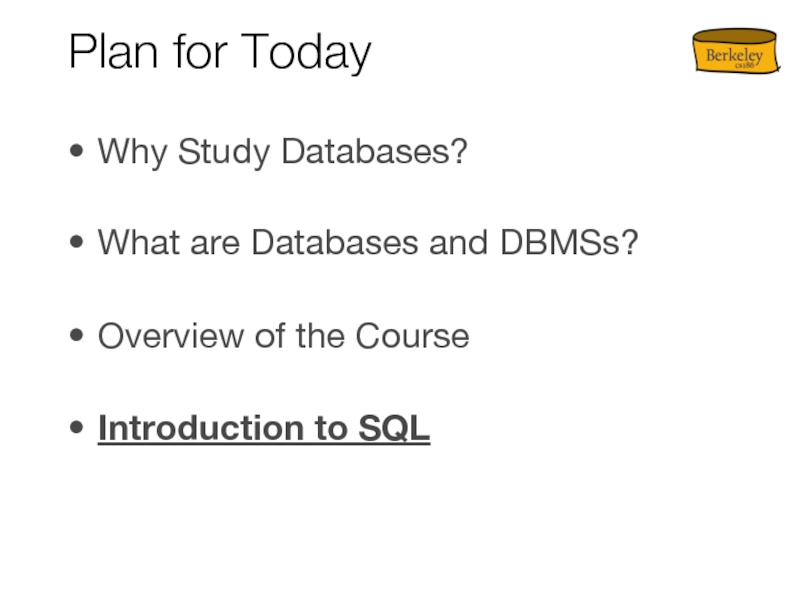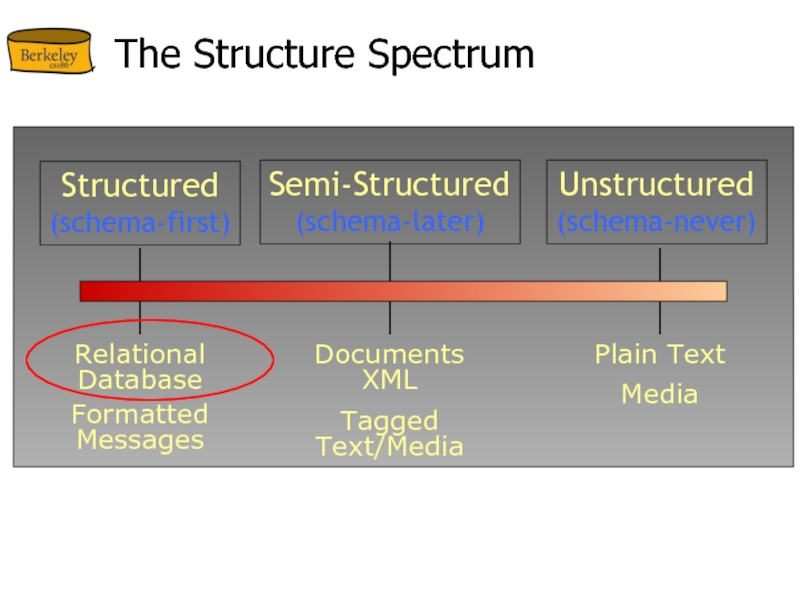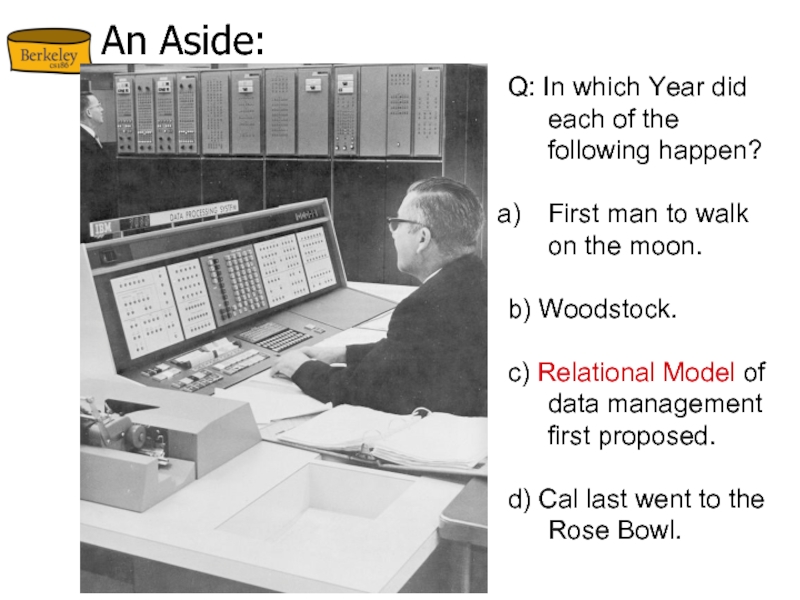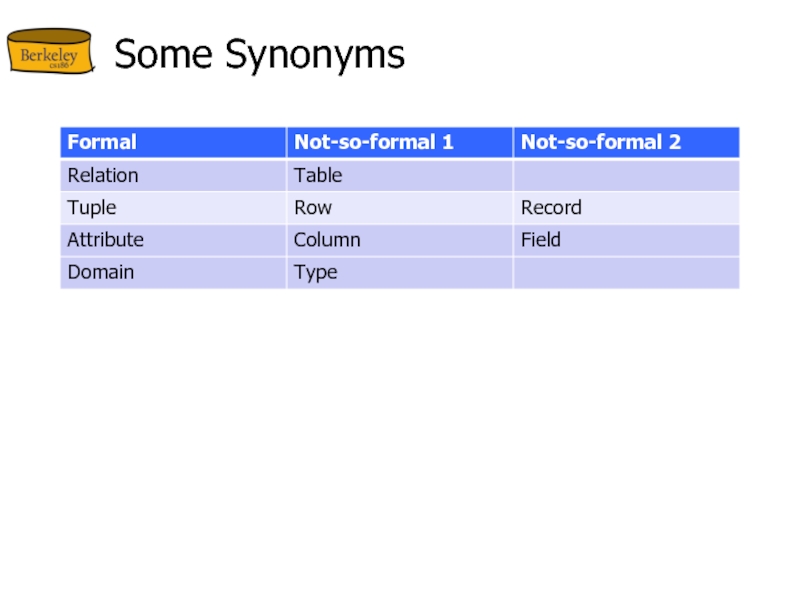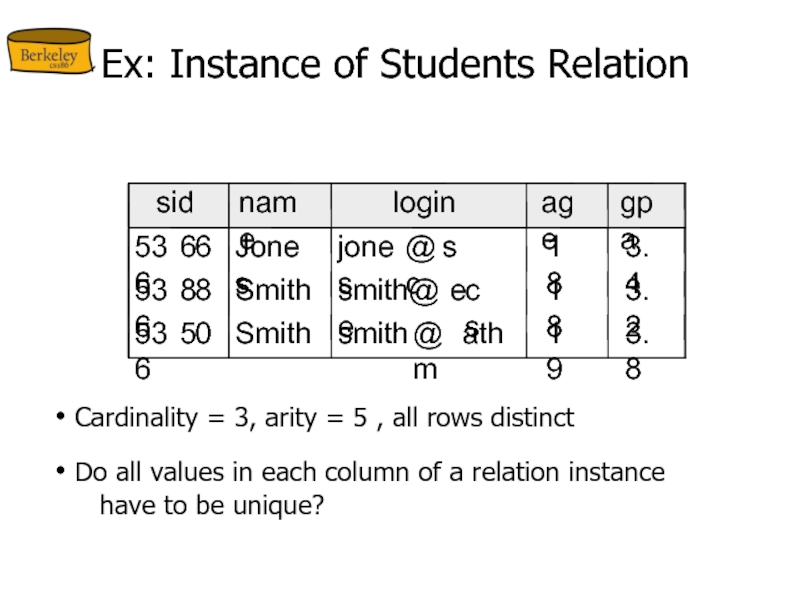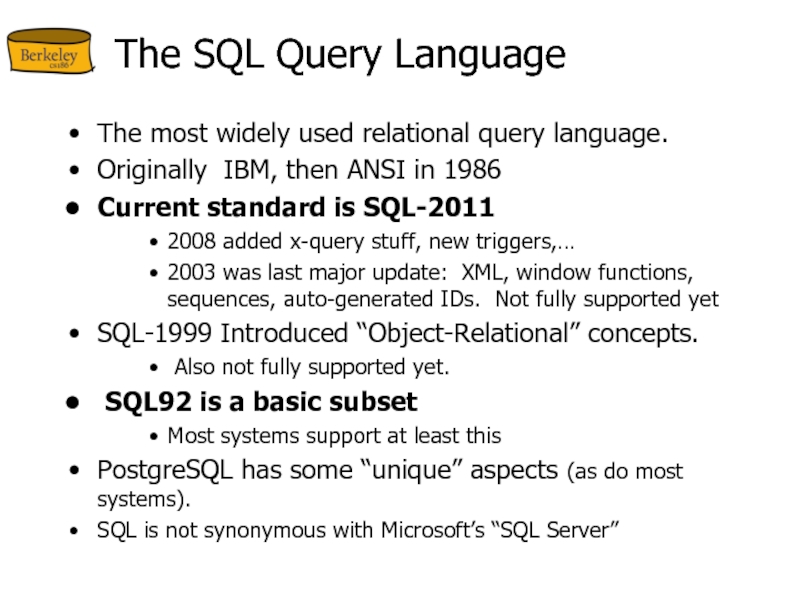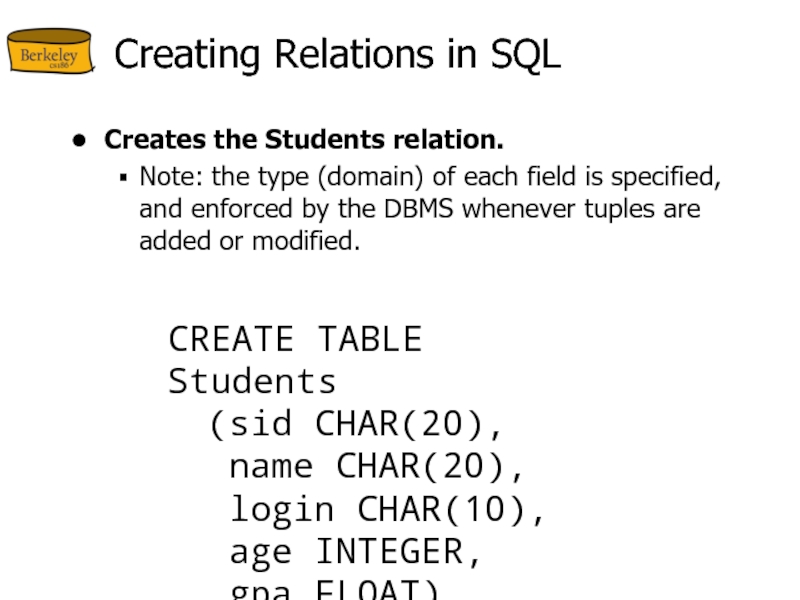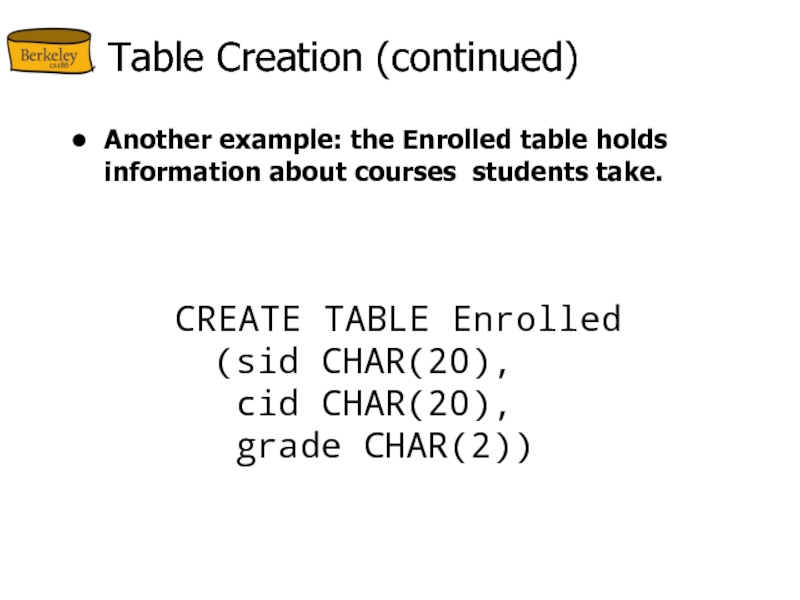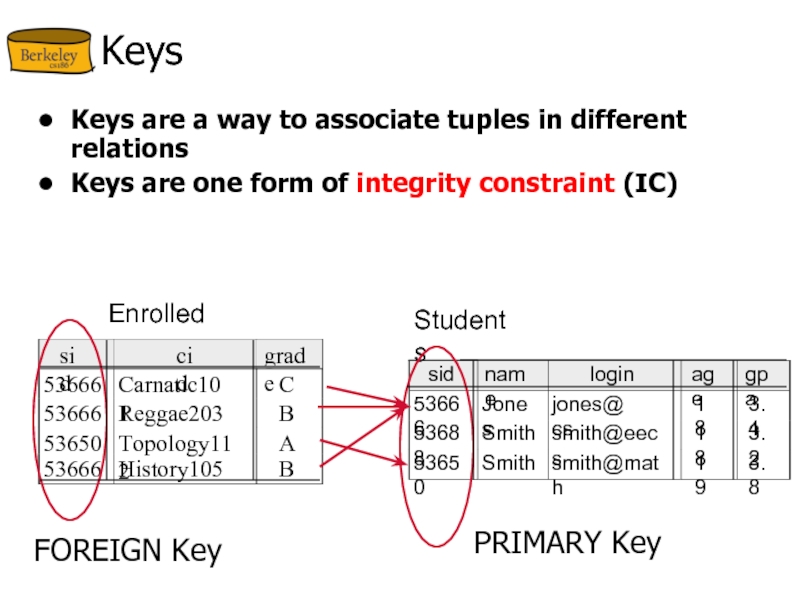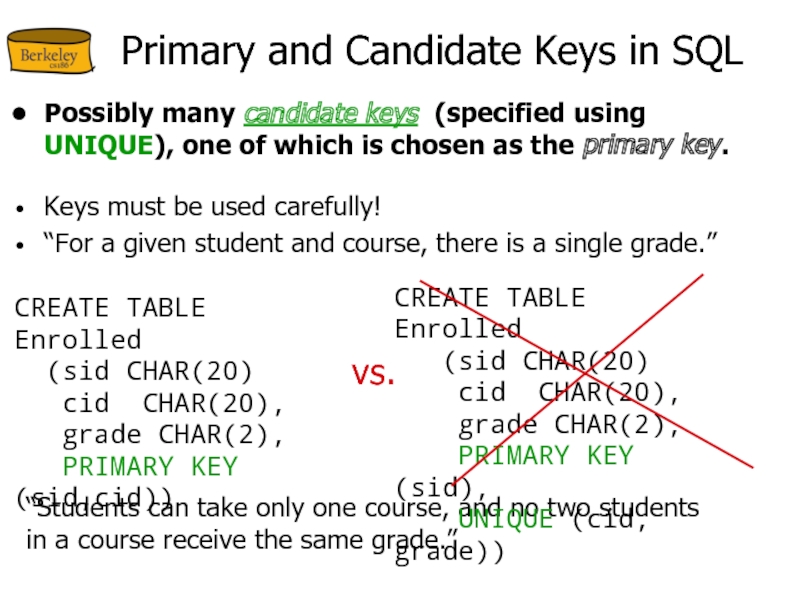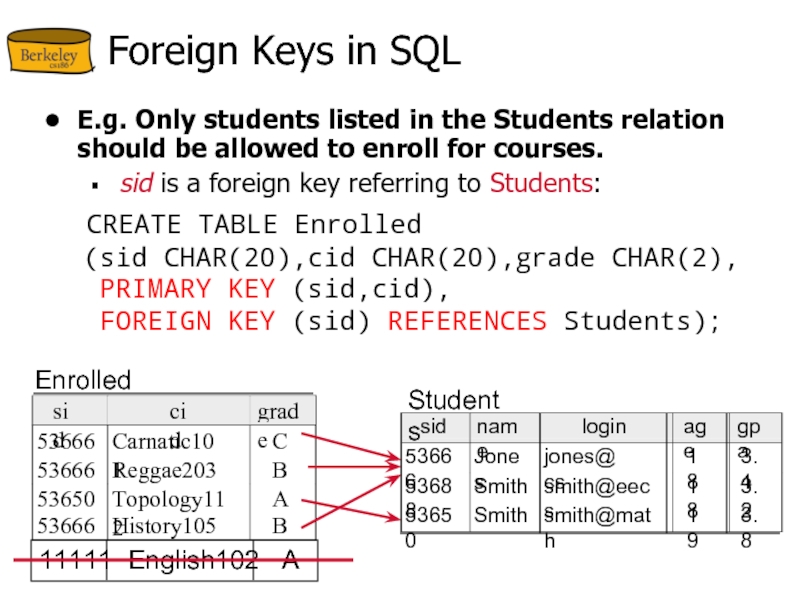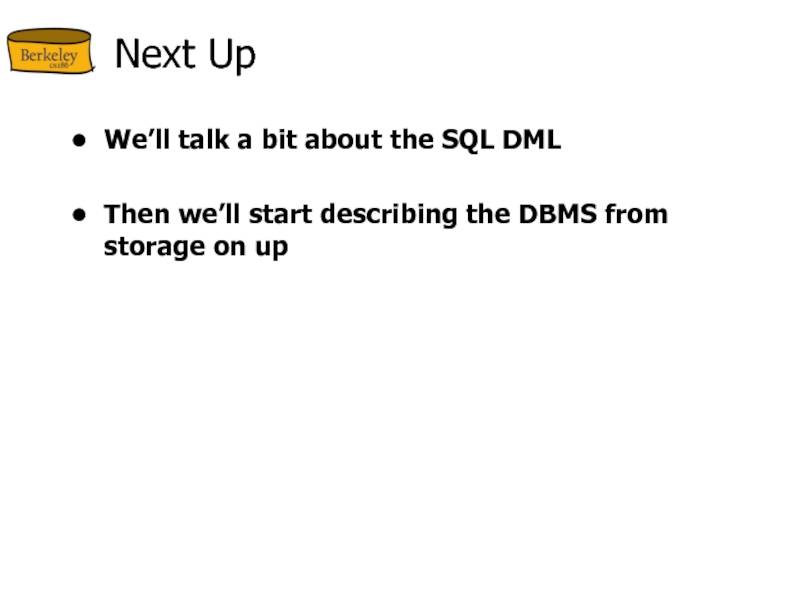- Главная
- Разное
- Дизайн
- Бизнес и предпринимательство
- Аналитика
- Образование
- Развлечения
- Красота и здоровье
- Финансы
- Государство
- Путешествия
- Спорт
- Недвижимость
- Армия
- Графика
- Культурология
- Еда и кулинария
- Лингвистика
- Английский язык
- Астрономия
- Алгебра
- Биология
- География
- Детские презентации
- Информатика
- История
- Литература
- Маркетинг
- Математика
- Медицина
- Менеджмент
- Музыка
- МХК
- Немецкий язык
- ОБЖ
- Обществознание
- Окружающий мир
- Педагогика
- Русский язык
- Технология
- Физика
- Философия
- Химия
- Шаблоны, картинки для презентаций
- Экология
- Экономика
- Юриспруденция
CS186 - Introductionto Database Systems презентация
Содержание
- 1. CS186 - Introductionto Database Systems
- 2. What I know about 186 Enrollment We
- 3. Plan for Today Why Study Databases? What
- 4. Databases – Why Study Them?
- 5. Databases – Why Study Them?
- 6. The “Big Data” Buzz – Why?
- 7. The “Big Data” Buzz – Why?
- 8. It’s All
- 9. Some Numbers by Industry Sources: "Big Data:
- 10. AMPLab@UC Berkeley
- 11. Big Data, Societal-Scale App? Cancer Tumor Genomics
- 12. What: Current Market Relational DBMSs anchor the
- 13. What is a Database?
- 14. Key Concept: Structured Data A
- 15. What is a Relational Database? [The Relational
- 16. In Other Words… Relational DataBase Management Systems
- 17. ANSI/SPARC Model Views describe how
- 18. Data Independence: Two Flavors A
- 19. Example: University Database
- 20. e.g.: An Instance of Students Relation
- 21. Example: University Database
- 22. What is a DBMS?
- 23. A DBMS Provides Users with the following:
- 24. A DBMS “Lasagna” Diagram
- 25. Key Concepts: Queries, Query Plans,
- 26. Plan for Today Why Study Databases? What
- 27. What will we learn? Design patterns for
- 28. Who? Instructor Prof. Michael Franklin (franklin@cs) TAs
- 29. How? Workload A New Set of Projects:
- 30. How? Administrivia http://inst.eecs.berkeley.edu/~cs186 or tinyurl.com/cs186fall2013
- 31. Plan for Today Why Study Databases? What
- 32. The Structure Spectrum
- 33. The Relational Model
- 34. An Aside: Q: In which
- 35. Relational Database: Definitions
- 36. Some Synonyms
- 37. Ex: Instance of Students Relation
- 38. SQL - A language for Relational DBs
- 39. The SQL Query Language The most widely
- 40. Creating Relations in SQL Creates
- 41. Table Creation (continued) Another example: the Enrolled
- 42. Adding and Deleting Tuples Can
- 43. Keys Keys are a way to associate
- 44. Primary Keys A set of
- 45. Primary and Candidate
- 46. Foreign Keys, Referential Integrity Foreign
- 47. Foreign Keys in SQL E.g. Only
- 48. Next Up We’ll talk a bit about
Слайд 1CS186 - Introduction to
Database Systems
Fall Semester 2013
Prof. Michael Franklin
“Knowledge is
-- Samuel Johnson (1709-1784)
Слайд 2What I know about 186 Enrollment
We are at capacity (room, section
actually oversubscribed – some attrition built in
about 40 people from the waitlist were let in yesterday
Wait list will be processed in order, but only as (if) people drop the course.
The further down the list you are the worse your odds
This happens for the next week and a half or so
We won’t be able to let in Concurrent Enrollment Students
A (smaller) offering of CS 186 is scheduled for next semester
Taught by visiting DB professor from Oxford
Michael-David Sasson (CS office) handles it from here
Слайд 3Plan for Today
Why Study Databases?
What are Databases and DBMSs?
Overview of the
Introduction to SQL
Слайд 6The “Big Data” Buzz – Why?
“Between the dawn of civilization and
(and others)
Слайд 7The “Big Data” Buzz – Why?
“The sexy job in the next
Hal Varian
Prof. Emeritus UC Berkeley
Chief Economist, Google
Слайд 8
It’s All Happening On-line
Every:
Click
Ad impression
Billing event
Fast Forward, pause,…
Friend Request
Transaction
Network message
Fault
…
User Generated
…..
Internet of Things / M2M
Scientific Computing
Sources Driving “Big Data”
Слайд 9Some Numbers by Industry
Sources:
"Big Data: The Next Frontier for Innovation, Competition
US Bureau of Labor Statistics | McKinsley Global Institute Analysis
Слайд 11Big Data, Societal-Scale App?
Cancer Tumor Genomics
Vision: Personalized Therapy
“…10 years from now,
Director, The Cancer Genome Atlas (TCGA), Time Magazine, 6/13/11
UCSF cancer researchers + UCSC cancer genetic database + UCB AMPLab
Слайд 12What: Current Market
Relational DBMSs anchor the software industry
Elephants: Oracle, IBM, Microsoft,
Open source: MySQL, PostgreSQL
New “Big Data” Entrants: Hive & Pig (Hadoop), Shark (Spark),
Obviously, Search
Google & Bing
Open Source “NoSQL”
Hadoop MapReduce, Spark
Key-value stores: Cassandra, Riak, Voldemort, Mongo, …
Cloud services
Amazon, Google AppEngine, MS Azure, Heroku, …
Слайд 14
Key Concept: Structured Data
A data model is a collection of concepts
A schema is a description of a particular collection of data, using a given data model.
The relational model of data is the most widely used model today.
Main concept: relation, basically a table with rows and columns.
Every relation has a schema, which describes the columns, or fields.
Слайд 15What is a Relational Database?
[The Relational Model] provides a basis for
Слайд 16In Other Words…
Relational DataBase Management Systems were invented to let you
(Curt Monash, analyst/blogger)
That is, think about the data independently of any particular program.
Слайд 17
ANSI/SPARC Model
Views describe how users see the data.
Conceptual schema defines logical structure
Physical schema describes the files and indexes used.
Physical Schema
Conceptual Schema
View 1
View 2
View 3
DB
Users
Слайд 18
Data Independence: Two Flavors
A Simple Idea: Applications should be insulated from
Q: Why is this particularly important for DBMS? (compared to your favorite programming language)
Physical data independence: Protection from changes in physical structure of data.
Logical data independence: Protection from changes in logical structure of data.
Слайд 19
Example: University Database
Conceptual schema:
Students(sid: string, name: string, login: string, age: integer, gpa:real)
Courses(cid: string, cname:string, credits:integer)
Enrolled(sid:string, cid:string, grade:string)
Note: fields high-lighted in green are unique keys or “primary keys”
Слайд 21
Example: University Database
Conceptual schema:
Students(sid: string, name: string, login: string, age: integer, gpa:real)
Courses(cid: string, cname:string, credits:integer)
Enrolled(sid:string, cid:string, grade:string)
Physical schema:
Relations stored as unordered files
Index on first column of Students, first 2 cols of Enrolled
External Schema (View):
Course_info(cid: string, enrollment: integer)
CREATE VIEW Course_info AS
SELECT cid, Count (*) as enrollment
FROM Enrolled
GROUP BY cid
Слайд 22What is a DBMS?
A database is an integrated and organized collection
A Database Management System (DBMS) is software that stores, manages and/or facilitates access to databases.
Слайд 23A DBMS Provides Users with the following:
“Declarative” Queries & Data Independence
Say
Help avoiding data corruption
Protection from other users/jobs/queries
As if you are the only person accessing the DB
Fault Tolerance and Durability
Database is protected even if failures occur in the middle of processing
Usually a bunch of tools and interfaces for building applications
Слайд 24
A DBMS “Lasagna” Diagram
Query Optimization
and Execution
Relational Operators
Access Methods
Buffer Management
Disk Space
Customer accounts stored on disk
Query in:
e.g. “Select min(account balance)”
Data out:
e.g. 2000
Database app
The book shows a somewhat more detailed version.
You will build a simple version of one of these
Слайд 25
Key Concepts: Queries, Query Plans, and Operators
System handles query
SELECT eid, ename, title
FROM Emp E
WHERE E.sal > $50K
SELECT E.loc, AVG(E.sal)
FROM Emp E
GROUP BY E.loc
HAVING Count(*) > 5
SELECT
COUNT DISTINCT (E.eid)
FROM Emp E, Proj P, Asgn A
WHERE E.eid = A.eid
AND P.pid = A.pid
AND E.loc <> P.loc
Issues: view reconciliation, operator ordering, physical operator choice, memory management, access path (index) use, …
Employees
Projects
Assignments
Слайд 26Plan for Today
Why Study Databases?
What are Databases and DBMSs?
Overview of the
Introduction to SQL
Слайд 27What will we learn?
Design patterns for dealing with (Big) Data
When, why
How Oracle and (a bit of) Google work
SQL ... and (a bit of) noSQL
Managing concurrency
Fault tolerance and Recovery
Useful concepts for Computer Science in general
and other sciences and endeavors as well!
Слайд 28Who?
Instructor
Prof. Michael Franklin (franklin@cs)
TAs
Lu Cheng+
Daniel Haas#
Evan Sparks#
Liwen Sun*#
Victor Zhu+
* Veteran CS
+ Former Star CS 186 Student (Undergrad)
# Database Grad Student, AMPLab Member
Слайд 29How? Workload
A New Set of Projects:
“SimpleDB” projects from MIT/UW
Done individually
Java-based implementations of key DBMS functions
5 project phases:
Files, Operators, Optimizer, Transactions, Recovery
Short weekly quizzes called “bunnies” (so as to be less scary – unless your aMonty Python fan)
Some Homeworks on SQL, Database Design, etc.
Likely using SQLite
Exams – 1 Midterm & 1 Final
1 Additional Project if you are in 286a (TBD)
Слайд 30How? Administrivia
http://inst.eecs.berkeley.edu/~cs186
or tinyurl.com/cs186fall2013
(site under construction)
Lecture notes will be posted
We will be using Piazza for most communication,
Office Hours: Prof. Franklin M 11-12, Th 3-4 pm
in 449 Soda Hall
TAs hours TBD
Sections start next week
Слайд 31Plan for Today
Why Study Databases?
What are Databases and DBMSs?
Overview of the
Introduction to SQL
Слайд 33
The Relational Model
The Relational Model is Ubiquitous
MySQL, PostgreSQL, Oracle, DB2, SQLServer,
Foundational work done at
IBM Santa Teresa Labs (now IBM Almaden in SJ) – “System R”
UC Berkeley CS – the “Ingres” System
Note: some Legacy systems use older models
e.g., IBM’s IMS
Object-oriented concepts have been merged in
Early work: POSTGRES research project at Berkeley
Informix, IBM DB2, Oracle 8i
As has support for XML (semi-structured data)
Слайд 34
An Aside:
Q: In which Year did each of the following happen?
First
b) Woodstock.
c) Relational Model of data management first proposed.
d) Cal last went to the Rose Bowl.
Слайд 35
Relational Database: Definitions
Relational database: a set of relations
Relation: made up
Schema : specifies name of relation, plus name and type of each column
Students(sid: string, name: string, login: string, age: integer, gpa: real)
Instance : the actual data at a given time
#rows = cardinality
#fields = degree / arity
Слайд 37
Ex: Instance of Students Relation
sid
name
login
age
gpa
536
6
6
Jones
jones
@c
s
18
3.4
536
8
8
Smith
smith@e
e
cs
18
3.2
536
5
0
Smith
smith
@m
ath
19
3.8
Cardinality = 3, arity = 5 , all rows distinct
Do all values in each column of a relation instance
have to be unique?
Слайд 38SQL - A language for Relational DBs
Say: “ess-cue-ell” or “sequel”
But spelled
Data Definition Language (DDL)
create, modify, delete relations
specify constraints
administer users, security, etc.
Data Manipulation Language (DML)
Specify queries to find tuples that satisfy criteria
add, modify, remove tuples
The DBMS is responsible for efficient evaluation.
Слайд 39The SQL Query Language
The most widely used relational query language.
Originally
Current standard is SQL-2011
2008 added x-query stuff, new triggers,…
2003 was last major update: XML, window functions, sequences, auto-generated IDs. Not fully supported yet
SQL-1999 Introduced “Object-Relational” concepts.
Also not fully supported yet.
SQL92 is a basic subset
Most systems support at least this
PostgreSQL has some “unique” aspects (as do most systems).
SQL is not synonymous with Microsoft’s “SQL Server”
Слайд 40
Creating Relations in SQL
Creates the Students relation.
Note: the type (domain) of
CREATE TABLE Students
(sid CHAR(20),
name CHAR(20),
login CHAR(10),
age INTEGER,
gpa FLOAT)
Слайд 41Table Creation (continued)
Another example: the Enrolled table holds information about courses
CREATE TABLE Enrolled
(sid CHAR(20),
cid CHAR(20),
grade CHAR(2))
Слайд 42
Adding and Deleting Tuples
Can insert a single tuple using:
INSERT INTO Students
VALUES ('53688', 'Smith', 'smith@ee', 18, 3.2)
Can delete all tuples satisfying some condition (e.g., name = Smith):
DELETE
FROM Students S
WHERE S.name = 'Smith'
Powerful variants of these commands are available;
more later!
Слайд 43Keys
Keys are a way to associate tuples in different relations
Keys are
sid
name
login
age
gpa
53666
Jones
jones@cs
18
3.4
53688
Smith
smith@eecs
18
3.2
53650
Smith
smith@math
19
3.8
sid
cid
grade
53666
Carnatic101
C
53666
Reggae203
B
53650
Topology112
A
53666
History105
B
Enrolled
Students
PRIMARY Key
FOREIGN Key
Слайд 44
Primary Keys
A set of fields is a superkey if:
No two distinct
A set of fields is a key for a relation if :
It is a superkey
No subset of the fields is a superkey
what if >1 key for a relation?
One of the keys is chosen (by DBA) to be the primary key. Other keys are called candidate keys.
E.g.
sid is a key for Students.
What about name?
The set {sid, gpa} is a superkey.
Слайд 45
Primary and Candidate Keys in SQL
Possibly many candidate keys (specified using
Keys must be used carefully!
“For a given student and course, there is a single grade.”
“Students can take only one course, and no two students in a course receive the same grade.”
Слайд 46
Foreign Keys, Referential Integrity
Foreign key: a “logical pointer”
Set of fields in
Reference to primary key of the other relation.
All foreign key constraints enforced?
referential integrity!
i.e., no dangling references.
Слайд 47
Foreign Keys in SQL
E.g. Only students listed in the Students relation
sid is a foreign key referring to Students:
CREATE TABLE Enrolled
(sid CHAR(20),cid CHAR(20),grade CHAR(2),
PRIMARY KEY (sid,cid),
FOREIGN KEY (sid) REFERENCES Students);
sid
cid
grade
53666
Carnatic101
C
53666
Reggae203
B
53650
Topology112
A
53666
History105
B
Enrolled
sid
name
login
age
gpa
53666
Jones
jones@cs
18
3.4
53688
Smith
smith@eecs
18
3.2
53650
Smith
smith@math
19
3.8
Students
Слайд 48Next Up
We’ll talk a bit about the SQL DML
Then we’ll start


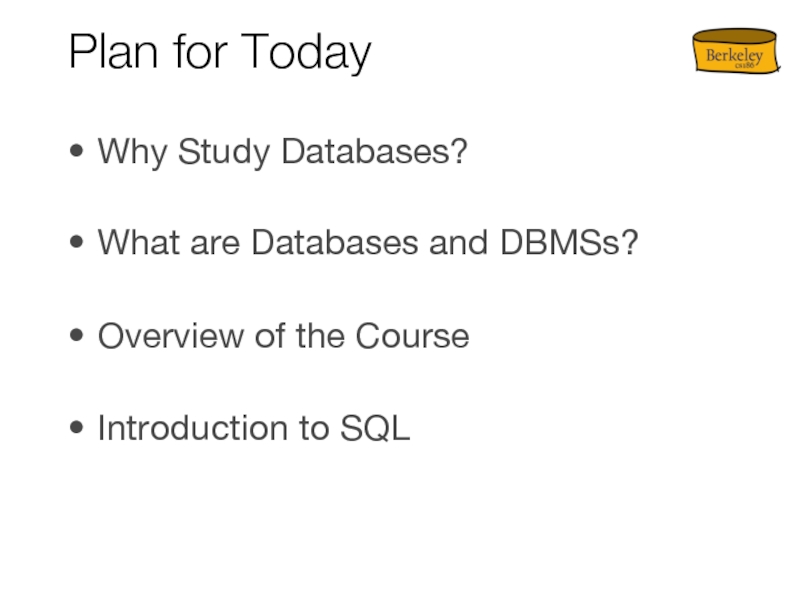

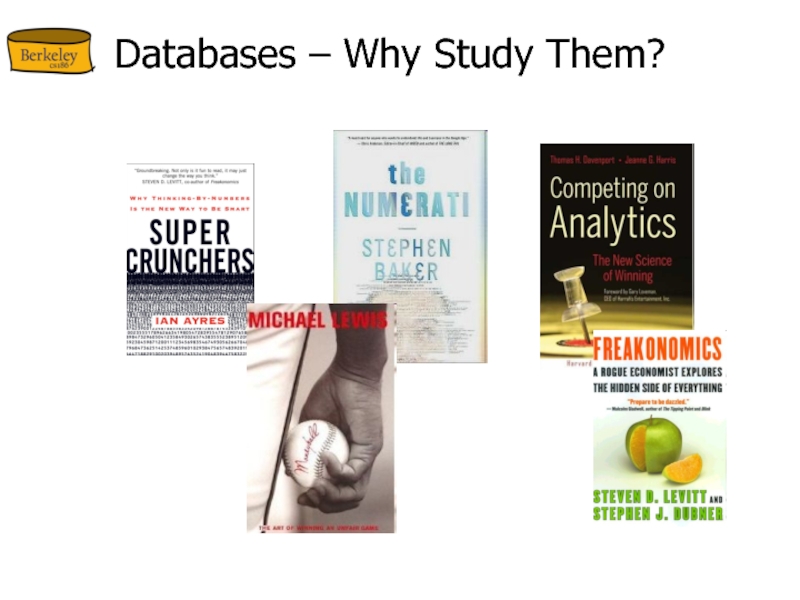

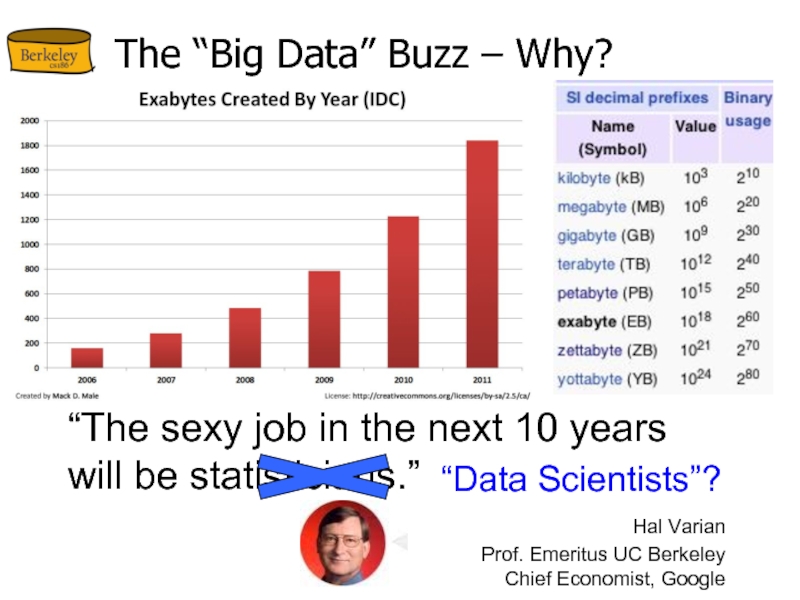


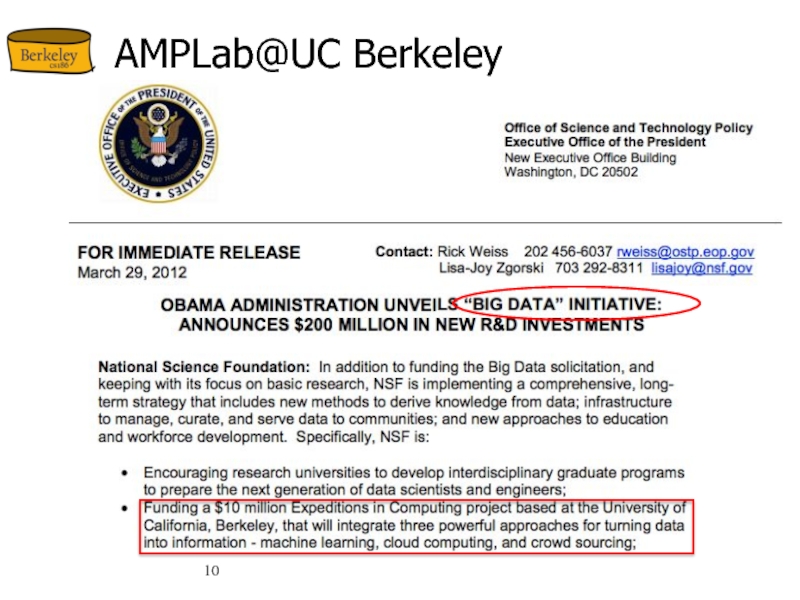
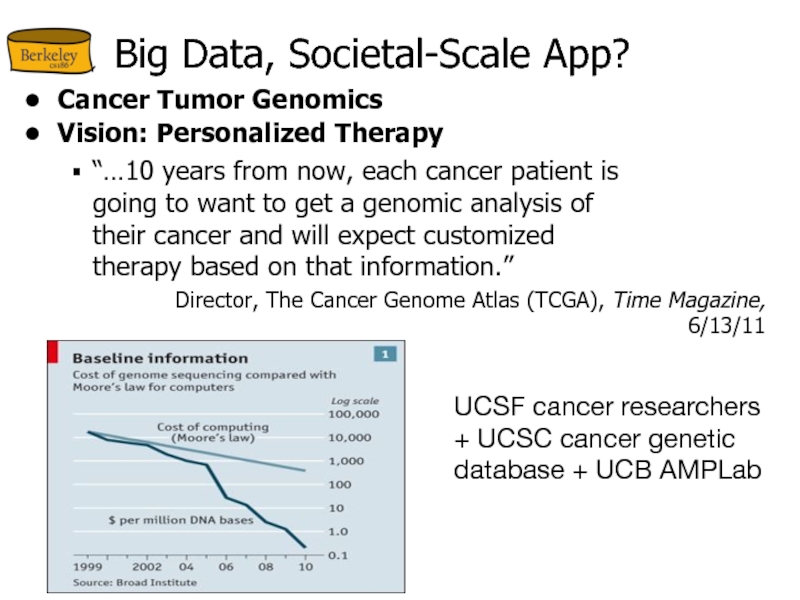



![What is a Relational Database?[The Relational Model] provides a basis for a high level data](/img/tmb/3/222695/a0c3130cb1b71f0c74b132af4350acd9-800x.jpg)
